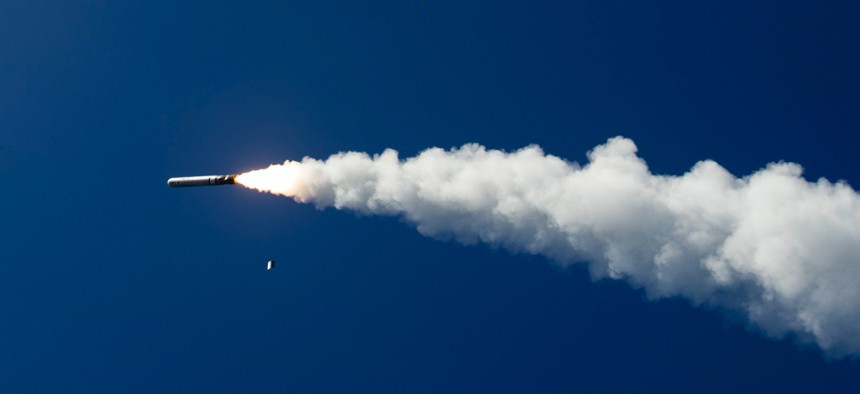By MONICA MONTGOMERY and KINGSTON REIF

President Joe Biden’s first real test of his commitment to reducing the role of nuclear weapons in U.S. national security strategy and trimming the bloated nuclear weapons budget is imminent. The administration released an initial topline version of its first national defense budget request on April 9 and is expected to release the full request in May or June. While a number of unnecessary and costly nuclear weapons programs should be critically reviewed by the administration, one program stands out for immediate cancellation: the Trump administration’s proposal for a new nuclear-armed sea-launched cruise missile.
Abandoning development of this new nuclear weapon should be an easy choice. Biden opposed the missile during his campaign for president and for good reason. The weapon would be a redundant and dangerous multi-billion-dollar mistake.
Three decades have passed since the United States last deployed nuclear cruise missiles at sea. President George H.W. Bush directed the nuclear Tomahawk Land Attack Missile to be taken off patrol in 1991 at the end of the Cold War. The weapons remained in storage in Washington state until the Obama administration identified them as a redundant capability in its 2010 Nuclear Posture Review and ordered their retirement.
To justify resurrecting the capability and deploying it on attack submarines or surface ships within a decade, the Trump administration pointed to a perceived gap in the U.S. arsenal of more usable low-yield (or non-strategic nuclear weapons). In addition, the administration argued that the missile could help convince Russia to negotiate more seriously about limiting its non-strategic weapons. The administration also said that the weapon would strengthen the credibility of tailored deterrent options in the Indo-Pacific region in the face of a more aggressive China.
But these arguments are unconvincing.
While Russia certainly possesses far more non-strategic warheads than the United States, the Trump administration presented no compelling evidence that Moscow believes Washington would be deterred from responding to Russian aggression due to “an asymmetry of [nuclear] yields.” Moreover, Russia has actually decreased its stockpile of non-strategic nuclear arsenal by one to three thousand warheads over the past decade, according to official U.S. government and expert assessments.
Regardless, the United States already deploys more than enough lower-yield nuclear options, including the air-delivered B61 gravity bomb and air-launched cruise missile, as well as the new low-yield submarine-launched ballistic missile warhead fielded by the Trump administration. The Pentagon and the Energy Department’s semiautonomous National Nuclear Security Administration have spent billions of dollars – and are planning to spend scores of billions more – to upgrade these weapons in the years ahead to ensure that they can defeat advancing adversary defenses.
Furthermore, a new sea-launched cruise missile would detract from the higher-priority conventional missions of the Navy and increase the possibility of conflict escalation through miscalculation.
Arming the surface or attack submarine fleets with nuclear cruise missiles would reduce the number of conventional missiles each boat could carry at a time when the Pentagon argues that the “erosion of conventional deterrence” is the greatest threat posed by China in the Indo-Pacific. To make matters worse, the service would face significant operational burdens associated with re-nuclearizing the vessels.
Mixing conventional and nuclear cruise missiles would also decrease the value of the conventional missiles – as any launch of a conventional missile would inherently send a nuclear signal – and increase the potential for unintended nuclear use in a conflict with a nuclear-armed adversary – since the adversary would have no way of knowing if the missile was nuclear or conventional.
Nor is bringing back a nuclear sea-launched cruise missile likely to be an effective arms control bargaining chip. A close examination of the history of U.S.-Russian arms control raises doubts about the strength of the link between increased U.S. spending on nuclear weapons and arms control success.
But even if the weapon were a useful chip, it’s not slated to be fielded until the end of the decade. And Russia has made it quite clear that its willingness to put non-strategic nuclear weapons on the negotiating table will depend on the U.S. willingness to put non-nuclear capabilities such as ballistic missile defense on the table in return.
Development of the sea-launched cruise missile has not yet begun, and only a tiny fraction of the large projected total cost has been expended thus far. To date, around $12 million has been provided for initiation studies on the weapon, a small drop in the bucket compared to the at least $9 billion in projected acquisition spending over the next decade on the missiles and its associated warhead. Additional funds, likely several billion dollars, would also be required to recertify ships or submarines to carry the weapons and to operate and sustain them.
Unless the Biden administration reverses course, the Navy is expected to request preliminary funding for the cruise missile in fiscal year 2022. The administration’s topline request indicated general support for ongoing nuclear modernization programs pending the outcome of a more detailed nuclear policy review, but specific funding levels for individual programs has yet to be divulged.
Biden should make good on this campaign promise by canceling or deferring the nuclear sea-launched cruise missile before it begins. If he does so, he should anticipate a strong base of support in Congress, where the reality of flat defense budgets and emphasis on upgrading the Navy’s conventional fleet and addressing other pressing security needs make for a powerful case against this unnecessary weapon.
No comments:
Post a Comment